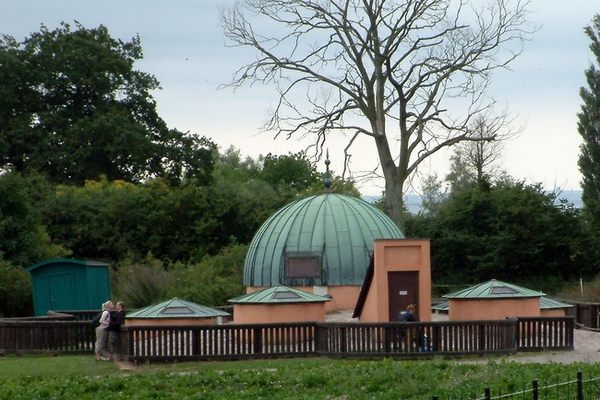About
The Earth wobbles slightly in its orbit, like a spinning top that draws ever-larger circles with its handle before it topples over. However, for our planet this process is extremely slow: the rotation axis completes one revolution (draws out one circle) every 26,000 years. The reason for this "precessional motion" can be traced back to the Earth's shape.
It is not a perfect sphere, but rather something called an "oblate spheroid." That means the Earth has a potbelly, a bulge wrapping around the equator, almost like a slightly flattened ball. This effect is itself a result of the Earth's rotation, as the centrifugal force that pushes outward from the center is greatest in the equatorial region. The gravitational attractions from the sun and moon then push and pull on the bulge, causing the Earth to gradually tip over.
The end result is the positions of the stars in the sky change over very long periods of time. For instance, while Polaris is the current North Star (the star directly overhead when standing at the North Pole), Vega in the constellation Lyra will assume this position in 13,000 years.
The Gaithersburg Latitude Observatory is one of six International Latitude Observatories that were built around the turn of the twentieth century to study the exact degree of the Earth's wobble. From 1899 to 1982 (with a gap between 1915 and 1932) nightly observations were recorded at the GLO in concert with those at the companion observatories in Ohio, California, Japan, Italy, and the Soviet Union (all of which occupy the same latitude of 39° 8’ N).
By making precise, long-term measurements of the locations of certain stars in the sky, scientists were able to ascertain the rate of Earth's precessional motion. Though the observations made in the 13 square foot room were relatively simple ones, the research that took place at GLO and the other observatories was paramount to establishing a deeper understanding of the Earth's rotation, size, and shape.
For instance, knowing the rate of precession is key to astronomers, who frequently need to adjust coordinates obtained by prior observers in order to account for the Earth's positional shift. And many more fields of science, from seismology and geodesy to climatology and space exploration, are also indebted to the observatory for its success in determining basic Earth properties. Perhaps most importantly, the Gaithersburg observatory is a symbol of cooperation in the international scientific community through periods of political differences, trying economies, and changing social climates.
The observatory itself is a National Historic Landmark, but there are several other points of interest on the property. These include the Meridian Mark Pier (a stone used to align the telescope), the brick caretaker's house from 1947, as well as five Coast and Geodetic Survey monuments that establish the exact coordinates, elevation, and magnetic field direction at the site.
In 2017, the telescope from the observatory was moved out of storage at the National Geodetic Survey and brought to its new location at the Gaithersburg Community Museum.
Related Tags
Know Before You Go
The observatory park is open every day from sunrise to sunset.The actual telescope can now be found nearby at the Gaithersburg Community Museum, 9 S. Summit Avenue, Gaithersburg, MD 20877.
Community Contributors
Added By
Published
March 2, 2010
Sources
- http://www.nps.gov/history/history/online_books/butowsky5/astro3.htm http://csep10.phys.utk.edu/astr161/lect/time/precession.html http://www-istp.gsfc.nasa.gov/stargaze/Sprecess.htm http://en.wikipedia.org/wiki/Gaithersburg_Latitude_Observatory
- http://www.gaithersburgmd.gov/about-gaithersburg/city-facilities/international-latitude-observatory
- https://www.nps.gov/places/gaithersburg-latitude-observatory.htm
- https://www.washingtonpost.com/local/a-workhorse-telescope-is-back-in-gaithersburg-md-not-far-from-its-old-home/2017/09/06/a3dd4ee4-92fc-11e7-89fa-bb822a46da5b_story.html?utm_term=.a79f9a050bd1

































